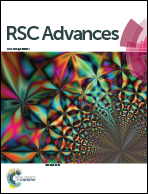A novel magnetic NiFe2O4@graphene–Pd multifunctional nanocomposite for practical catalytic application†
Abstract
In this paper, we report a simple, efficient, and facile strategy to prepare a magnetically separable NiFe2O4@GN–Pd nanocomposite under hydrothermal conditions. This new kind of hybrid material has been fully characterized by powder X-ray diffraction (XRD), Fourier transform infrared spectroscopy (FT-IR), Raman spectroscopy, X-ray photoelectron spectroscopy (XPS), transmission electron microscopy (TEM) and vibrating sample magnetometry (VSM). The hybrid is constructed by spherical NiFe2O4 and Pd nanoparticles with the particle sizes in the range of 10–20 nm, which are confined by monolayered GN sheet. The magnetic measurements show that the sample exhibits a typical superparamagnetic behavior, while presents finite coercivity of 9.46 Oe at room temperature. The saturation magnetization of the sample (36.82 emu g−1) is significantly lower than that for the reported bulk NiFe2O4 particles (55 emu g−1), which also reflects the ultrafine nature of the sample. The as-prepared NiFe2O4@GN–Pd nanocomposite is an ideal recyclable catalyst for liquid-phase reactions owing to its stability and efficient magnetic separation. The Suzuki coupling reaction is used to demonstrate the catalytic efficiency. Additionally, the catalyst is completely recoverable with the simple application of an external magnetic field and the catalytic efficiency shows no obvious loss even after six repeated cycles. The easy synthesis, good magnetic performance and recoverability of the NiFe2O4@GN–Pd nanocomposite make it a promising catalytic material.


 Please wait while we load your content...
Please wait while we load your content...